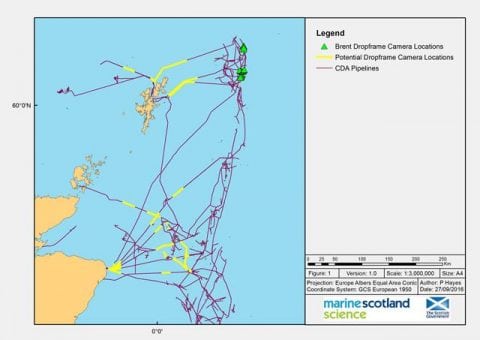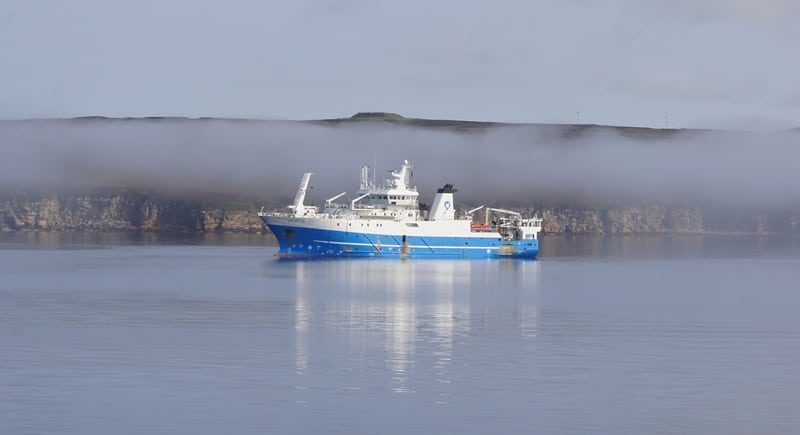Marine
MRV Scotia Survey 1516S Programme
November 18, 2016 by Marine Directorate Communications No Comments | Category Marine Directorate general, Marine Directorate Science, Marine Directorate Surveys, Research Vessel Surveys
Duration: 14 October – 3 November 2016
Fishing gear: Day grabs; TV drop frame with lasers (including rectangular footprint); armoured cable; Swathe multibeam echosounder system; RoxAnn system; Scout System; and smolt trawl.
Objectives:
- To undertake bathymetric and ground-truthing survey work in connection with offshore oil and gas pipelines associated with the Brent facilities.
- To undertake bathymetric and ground-truthing survey work in connection with offshore oil and gas pipelines that are protected and located within areas that are routinely crossed by demersal fishing gear.
- To undertake trials of the smolt trawl in Aberdeen Bay/ Moray Firth
Procedure:
MRV Scotia will depart from Aberdeen Harbour at 08:00 on 14 October. Before making passage to the pipeline stations, Scotia will calibrate the multibeam system off Stonehaven. The nature of the survey work will be heavily dependant on the prevailing weather conditions encountered. The proposed survey is very similar to the work conducted for the previous Renewable and Energy Programme survey in 2015. The survey work sites are annotated in Figure 1.
A sound velocity profile (SVP) will be collected 500 m outside of the survey location. On completion of the SVP, MRV Scotia will complete a multibeam swathe along the length of the targeted pipeline. Survey speed will be 4 knots. The output will be checked for any anomalous features that could interact with other survey equipment. If features are identified MRV Scotia will relocate in the immediate area and repeat the multibeam swathe along the pipeline until a suitable length of pipeline is identified.
The multibeam data will be assessed to identify changes in the seabed substrate. The substrates will be ground-truthed using a drop-frame camera. The drop-frame will be deployed 500 m from the pipeline off the stern of the vessel using an armoured cable. The drop-frame will be kept at 1.5 m above the seabed/pipeline and towed using the vessel’s bow thrusters at a speed of 1 knot or less (0.5 m per second) on a course perpendicular to the pipeline. Video capability on the drop-frame will be forward looking and vertically mounted. It will also have a transponder enabling its position to be monitored and recorded. The maximum time spent transecting the pipeline will be less than 5 seconds.
On completion of the TV tows additional multibeam transects will be run parallel to the pipeline alternating the direction of travel for each tow. This will be continued until up to 500 m of seabed has been surveyed on each side of the pipeline. Surface sediment samples will be collected using a day grab to provide additional ground-truthing information.
On completion of the pipeline survey work, MRV Scotia will relocate to Aberdeen Bay or Moray Firth to build on the 2015 trials using the recently commissioned Smolt trawl. This comprises a pelagic video trawl net for use close to the surface for the enumeration of salmon and sea trout smolts as they emigrate through near coastal waters in spring. The key purpose for the days allocated on Scotia are to test the net will function correctly. This type of net is new to the Scotia crew, and they will establish protocols for shooting and retrieving the net and accompanying equipment as a prelude to more extensive work during the smolt run of 2016 in the Moray Firth. The net is designed to operate close to the surface with entrained fish directed through a detachable camera and PIT detector frame at its end. Although the first deployments may be without the frame in place, it is intended to test the deployment and operation of the camera set up and PIT detector arrangements at an early stage in the testing.
Shooting the net may require a depth of 50 m, although it is expected that once the net is underway and the doors have lifted that it will be able to operate in water shallower that this.
MRV Scotia will complete port calls at Aberdeen on 21 and 30 October to exchange scientific staff. The second half landing will be followed by the relocation of the survey work into the Moray Firth. On completion of the survey work MRV Scotia will return to unload at Aberdeen Harbour on the 3 November.
Tags: MRV Scotia, Stonehaven, Swathe multibeam echosounder



Leave a comment